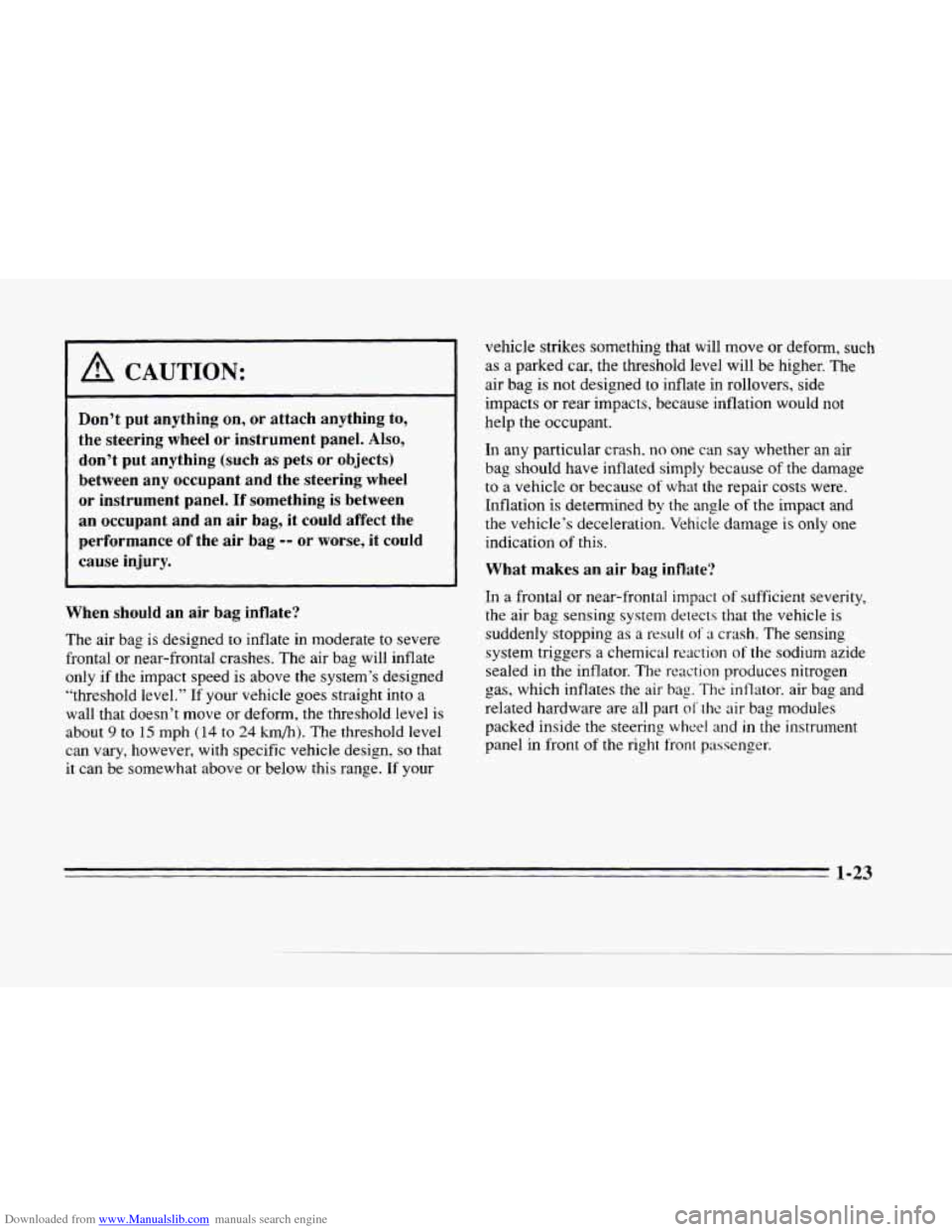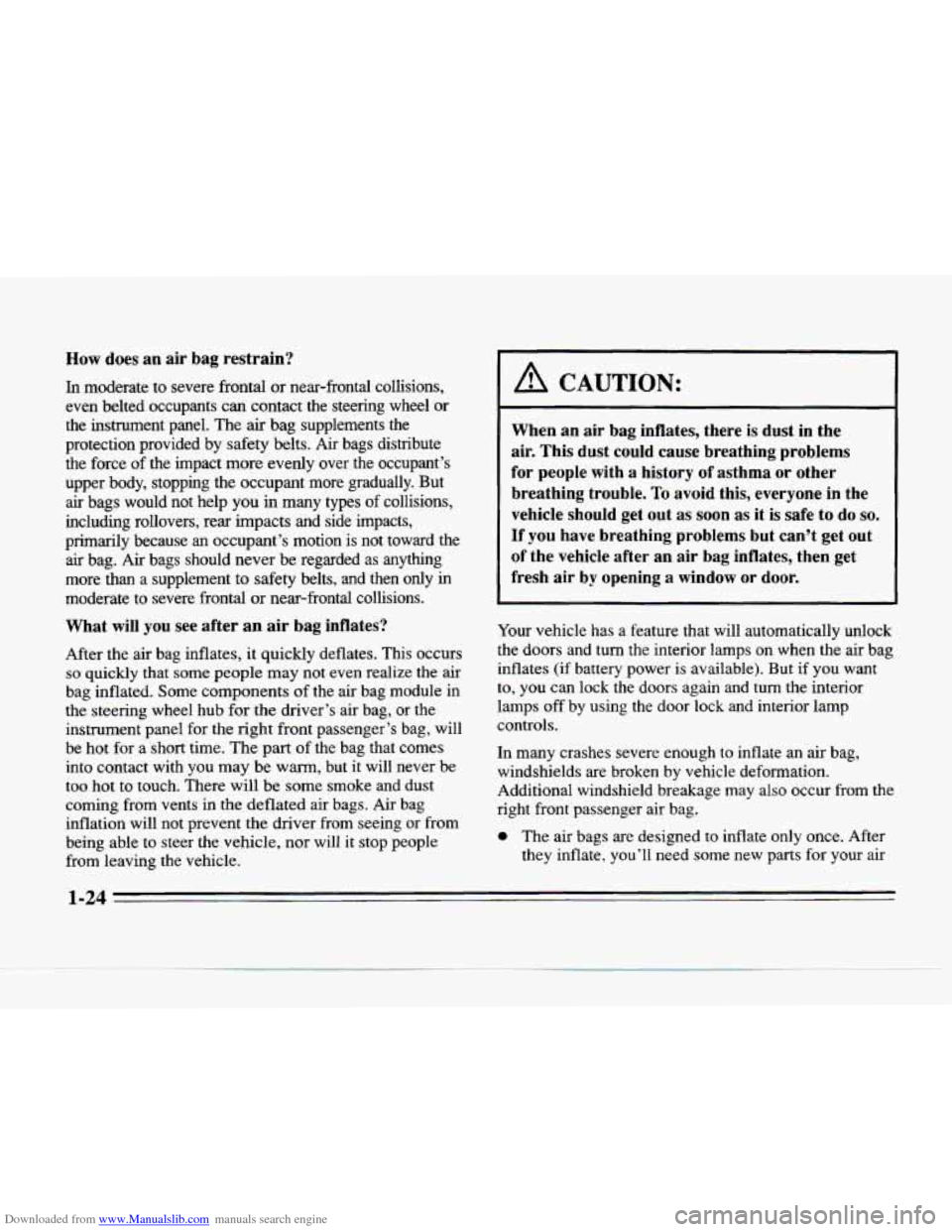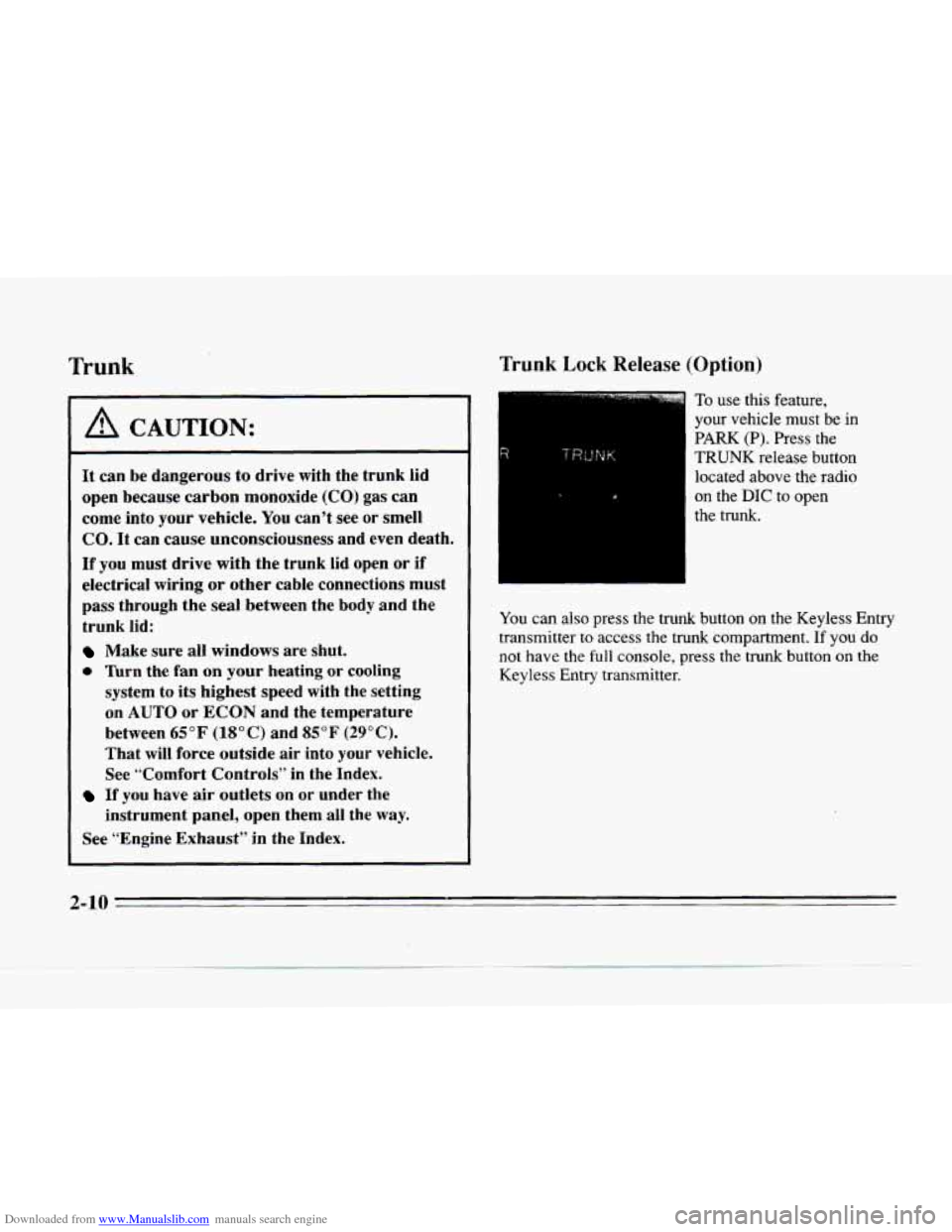Page 25 of 354
Downloaded from www.Manualslib.com manuals search engine or the instrument panel ... or the safety belts!
With safety belts,
you slow down as the vehicle does.
You get more time to stop. You stop over more distance,
and your strongest bones take
the forces. That's why
safety belts make such
good sense.
-
Page 36 of 354
Downloaded from www.Manualslib.com manuals search engine c
c
A CAUTION:
Air bags inflate with great force, faster than the
blink of an eye.
If you’re too close to an inflating
air bag, it could seriously injure you. Safety belts
help keep you
in position for an air bag inflation
in
a crash. Always wear your safety belt, even
with an
air bag. The driver should sit as far back
as possible while still maintaining control of the
vehicle.
I A CAUTION:
An inflating air bag can seriously injure small
children. Always secure children properly
in your
vehicle.
To read how, see the part of this manual
called “Children” and the caution label on the
right front passenger’s safety belt.
11 There is an air bag
AIR BAG
readiness light on the
instrument panel, which
shows AIR
BAG.
The system checks the air bag’s electrical system for
malfunctions. The light tells
you if there is an electrical
problem. See
“Air Bag Readiness Light” in the Index
for more information.
1 31
Page 37 of 354
Downloaded from www.Manualslib.com manuals search engine How the Air Bag System Works
Where is the air bag?
The driver's air bag is in the middle of the steering
wheel.
I
The right front passenger's air bag is in the instrument
panel on the passenger's
side.
1-22
Page 38 of 354

Downloaded from www.Manualslib.com manuals search engine c
c
1 A CAUTION:
Don’t put anything on, or attach anything to,
the steering wheel or instrument panel.
Also,
don’t put anything (such as pets or objects)
between any occupant and the steering wheel
or instrument panel.
If something is between
an occupant and an air bag, it could affect the
performance
of the air bag -- or worse, it could
cause injury.
When should an air bag inflate?
The air bag is designed to inflate in moderate to severe
frontal or near-frontal crashes. The air bag will inflate
only
if the impact speed is above the system’s designed
”threshold level.” If your vehicle
goes straight into a
wall that doesn’t move or deform, the threshold level is
about
9 to 15 mph (14 to 24 km/h). The threshold level
can vary, however, with specific vehicle design,
so that
it can be somewhat above or below this range. If your vehicle strikes
something that will move or deform, such
as
a parked car, the threshold level will be higher. The
air bag
is not designed to inflate in rollovers, side
impacts or rear impacts, because inflation would not
help the occupant.
In any particular crash.
no one can say whether an air
bag should have inflated simply because of the damage
to a vehicle or because
of what the repair costs were.
Inflation
is determined by the angle of the impact and
the vehicle’s deceleration. Vehicle damage is only one
indication
of this.
What makes an air bag inflate‘?
In a frontal or near-frontal impact of sufficient severity,
the air bag sensing system detects that the vehicle is
suddenly stopping as
a result 01 ;L crash. The sensing
system triggers a chemical reaction
of the sodium azide
sealed
in the inflator. The reaction produces nitrogen
gas, which inflates the air
bag. The intlator. air bag and
related hardware are all part
of’the air bag modules
packed inside the steering
wheel and in the instrument
panel in front
of the right fronl passenger.
1 -23
Page 39 of 354

Downloaded from www.Manualslib.com manuals search engine How does an air bag restrain?
In moderate to severe frontal or near-frontal collisions,
even belted occupants can contact the steering wheel or
the instrument panel. The air bag supplements the
protection provided by safety belts.
Air bags distribute
the force of the impact more evenly over the occupant’s
upper body, stopping the occupant more gradually.
But
air bags would not help you in many types of collisions,
including rollovers, rear impacts and side impacts,
primarily because
an occupant’s motion is not toward the
air bag. Air bags should never be regarded as anything
more than
a supplement to safety belts, and then only in
moderate to severe frontal or near-frontal collisions.
What will you see after an air bag inflates?
After the air bag inflates, it quickly deflates. This occurs
so quickly that some people may not even realize the air
bag inflated. Some components
of the air bag module in
the steering wheel hub for
the driver’s air bag, or the
instrument panel for the right front passenger’s bag, will
be hot for a short time. The part
of the bag that comes
into contact with you
may be warm, but it will never be
too hot to touch. There will be some smoke and dust
coming from vents in the deflated air bags. Air bag
inflation will not prevent the driver from seeing or from
being able to steer the vehicle, nor will it stop people
from leaving the vehicle.
~
A CAUTION:
When an air bag inflates, there is dust in the
air. This dust could cause breathing problems
for people with a history of asthma
or other
breathing trouble.
To avoid this, everyone in the
vehicle should get out as soon as it is safe to do
so.
If you have breathing problems but can’t get out
of the vehicle after an air bag inflates, then get
fresh air by opening
a window or door.
Your vehicle has a feature that will automatically unlock
the doors
and turn the interior lamps on when the air bag
inflates
(if battery power is available). But if you want
to, you can lock the doors again and turn the interior
lamps
off by using the door lock and interior lamp
controls.
In many crashes severe enough
to inflate an air bag,
windshields are broken by vehicle deformation.
Additional windshield breakage may also occur
from the
right front passenger air bag.
0 The air bags are designed to inflate only once. After
they inflate, you’ll need
some new parts for your air
-24
Page 60 of 354
Downloaded from www.Manualslib.com manuals search engine ,-L- -*-,
Section 2 Features and Controls
Here you can learn about the many standard and optional
features on your Cadillac, and information on starting,
shrfting and braking. Also explained are the instrument
panel
and the warning systems that tell you if everything is
working properly -- and what to do if you have a problem.
Keys
A CAUTION:
Leaving young children in a vehicle with the
ignition key
is dangerous for many reasons. A child
or others could be badly injured
or even killed.
They could operate power windows or other
controls or even
make the vehicle move. If they
turned the ignition to
on and moved the shift
lever out
of PARK (P), that would release the
parking brake. Don't leave the keys in
a vehicle
with young children.
3:
yl . . . . . ,.
2-1
Page 69 of 354

Downloaded from www.Manualslib.com manuals search engine Frunk
A CAUTION:
It can be dangerous to drive with the trunk lid
open because carbon monoxide
(CO) gas can
come into your vehicle.
You can’t see or smell
CO. It can cause unconsciousness and even death.
If you must drive with the trunk lid open or if
electrical wiring
or other cable connections must
pass through the seal between the body and the
trunk lid:
Make sure all windows are shut.
e lhrn the fan on your heating or cooling
system to its highest speed with the setting
on
AUTO or ECON and the temperature
between
65°F (18OC) and 85°F (29°C).
That will force outside air into your vehicle.
See “Comfort Controls” in the Index.
instrument panel, open them all the
way.
If you have air outlets on or under the
See “Engine Exhaust” in the Index.
Trunk Lock Release (Option)
TRUNK
To use this feature,
your vehicle must
be in
PARK (P). Press the
TRUNK release button
located above the radio
on the
DIC to open
the trunk. P
You can also press the trunk button on the Keyless Entry
transmitter to access the trunk compartment.
If you do
not have the full console, press the trunk button on the
Keyless Entry transmitter.
2-10
Page 83 of 354
Downloaded from www.Manualslib.com manuals search engine Parking Brake
Hold the regular brake
pedal down with your right
foot and push down the
parking brake pedal with
your left foot to set the
parking brake.
If the
ignition is on, the
PARK
BRAKE indicator light will
3
come on.
If you try to drive off with the parking brake on, the
PARK BRAKE indicator light stays on. See “Parking
Brake Indicator Light”
in the Index for more infomation.
When
you move out of PARK (P) or NEUTRAL (N), if
the engine is running, the parking brake should release. If
it doesn’t, you can manually release the parking brake.
Reach under the driver’s side of the instrument panel
and pull on the manual release lever.
which is located
above the parking brake pedal. If the
parking brake does
not release, you will have
to have your vehicle serviced.
2-24